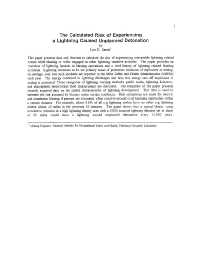Mining Publication: The Calculated Risk of Experiencing a Lightning Caused Unplanned Detonation
Original creation date: February 1998
This paper presents data and theorem to calculate the risk of experiencing undesirable lightning related events while blasting or while engaged in other lightning sensitive activities. The paper provides an overview of lightning hazards in blasting operations and a brief history of lightning related blasting accidents. Lightning continues to be the primary cause of premature initiations of explosives in mining; on average, over two such incidents are reported to the Mine Safety and Health Administration (MSHA) each year. The energy contained in lightning discharges and how this energy sets off explosives in mining is presented. Three categories of lightning warning methods: public media, lightning detectors, and atmospheric electrostatic field measurement are discussed. The remainder of the paper presents recently acquired data on the spatial characteristics of lightning development. This data is used to estimate the risk assumed by blasters under certain conditions. Risk estimations are made for electric and nonelectric blasting if persons are evacuated when cloud-to-ground (c-g) lightning approaches within a certain distance. For example, about 0.6% of all c-g lightning strikes have no other c-g lightning strikes within 25 miles in the previous 30 minutes. The paper shows that a typical blaster using nonelectric initiation in a high lightning density area with a 100% accurate lightning detector set to alarm at 25 miles would have a lightning caused unplanned detonation every 14,000 years.
Authors: LD Santis
Conference Paper - February 1998
NIOSHTIC2 Number: 20000112
Proceedings of the Fourteenth Annual Symposium on Explosives and Blasting Research, 1998 Feb :107-119
See Also
- Blasting and Explosives
- A Gas Pressure-Based Drift Round Blast Design Methodology
- Performance of RETIMET Metal Foam Vents on Explosion-Proof Enclosures
- Post-Explosion Observation of Experimental Mine and Laboratory Coal Dust Explosions
- Post-Explosion Observations of Experimental Mine and Laboratory Coal Dust Explosions
- Progress Toward Improved Engineering of Seals and Sealed Areas of Coal Mines
- Refuge Chamber Expectations Training - 1.0
- Rock Dusting Considerations in Underground Coal Mines
- Technology News 535 - NIOSH Releases New Educational Video: Escape from Farmington No. 9: An Oral History
- Toolbox Training on Flyrock Awareness
- Page last reviewed: 9/21/2012
- Page last updated: 9/21/2012
- Content source: National Institute for Occupational Safety and Health, Mining Program


 ShareCompartir
ShareCompartir
